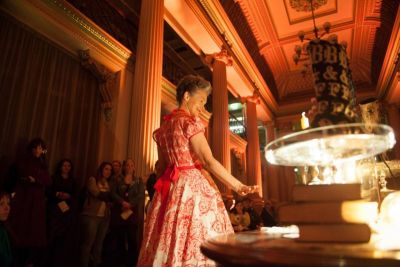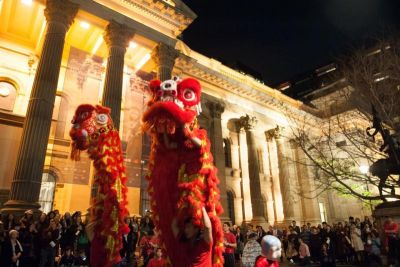Liberty of the Press
Who would have expected that Melbourne Fashion Week could include such an original gem of a spectacle as Liberty of the Press?
We waited, not knowing what to expect, in the dim light under the magnificent high dome of the La Trobe Reading Room in the State Library of Victoria. All around us, people who were not, apparently, the audience, sat under their green reading lamps, doing what people normally do in libraries and perhaps wondering what was going on.

Suddenly, a handsome fellow in 19th century attire appeared on the central platform. He struck a large metal gong. The sound reverberated up and around the vaulted space. He ran his wooden striker around the gong’s rim and the gong began to sing. As if from nowhere a woman in a crinoline dress glided through those of us who, moments ago, were waiting for something to happen. The woman was graceful and had a serene smile as she moved to the doors to the Queen’s Hall. Her dress was of a curious black and white printed fabric. When we looked closely, we saw that the print was squares of newsprint bordered by gold. Then another woman, likewise serene, threaded through the now spellbound crowd. Her crinoline dress too was of newsprint. And then a third woman in a crinoline newsprint dress ascended above the gentleman on the central platform. She carried a snare drum. She played a martial beat that soon became emphatic, almost frenzied – before the distinctive booms of Chinese drums, which, till now, were hidden, joined its clatter. Long pennants tumbled down from the top balconies on all four sides. They showed images of Sir Redmond Barry (founder of this very library), of the Masonic eye, the banner heads of long gone newspapers and the title, Freedom of the Press. The drummer woman joined the other two crinolines. They led us, they ushered us, into the Queen’s Hall – past one who now sang beautifully something we felt sure was of the 19th century also. And we surged gently into softly lit Queen’s Hall with its columns and pink and white and gold, some turning left and some right, past a stature dressed in a ball dress of squares of 19th century newspapers. We perched on spindly gilded chairs like those beside any catwalk. Eerie, transporting music played and an original and quite unforgettable ‘fashion parade’ began…

In 1866, Mrs Matilda Butters, in the city of Melbourne, in the colony of Victoria, created her ‘Press Dress’ for the Lord Mayor’s Ball. It was an attention getting provocation. She printed a selection of headlines and articles from newspapers onto fabric and had made a dress that was a sensation, the talk of the town. (Indeed, it is the dress that we passed as we entered the hall; it survives – donated to the library in 1951.) Mrs Butters, it’s true, did amend some text before printing in order to advance the political ambitions of her husband, but there was no mention in any newspaper of any woman (except as consort of some prominent man) or of the 40,000 Chinese on the goldfields and in Melbourne itself (or of children or Aboriginals).
Director of this intriguing and moving tribute to Mrs Butters, Penelope Bartlau, began her thinking and research with Mrs Butters’ gesture (hence the three crinoline dresses with their newsprint fabrics) and then, on meeting the slightly eccentric and very original Costume and Fashion designers Sharmaine and Dale Cornel, decided to honour the untold lives and stories of the time.

And so, in the Queen’s Hall, subtly lit by Richard Vabre, to Darius Kedros’ atmospheric music and sound design, we got a fashion parade in which, instead of the standard sullen size 6 stick instinct models, we saw women of many shapes and sizes, ranging in age from 22 to 63 – all deliberately ‘cast’ by Ms Bartlau. They did not strut, they strolled, they cruised, they were curiously sensual. They made eye contact with the audience and, most important, eye contact with each other. They smiled at each other. Each wore her own specifically bespoke distinctive and expressive (rather than ‘period’) ensemble of printed fabric costume and shoes. In groups of three, they took turns to create tableaux in which a series of emphatic gestures expressed both Chinese and women’s experiences and emotions. Although it was not immediately clear what every movement or gesture meant – it was an entirely non-verbal spectacle - that seemed not to matter. The emotional import was clear. As the ‘models’ began to clear the space, Chinese drumming, cymbals and two superbly coordinated ‘dragons’ succeeded them. (No credits available for these very skilled performers who played and animated their dragons so well.) Part 3 of the evening was called, ‘Chinese Spectacle & Glowing Ladies’; this took place on the forecourt of the library. The two dragons danced and writhed and were provoked while the first three crinoline dress women looked on benignly (which the Melbourne ladies whom they represented almost certainly did not).
 At a subsequent ‘Artists’ Salon Talk’ in the Red Rotunda of the library, the panel of creators spelled out the rationale, the intentions and the development of this quite magical presentation. As is often the case, a great deal of conscientious thought had gone into what we had just seen, but the intended significance was not always clear. There was a certain quotient of what sounded like pretentious waffle talked. (Isn’t it often so much better for the visual or performance artist to present their work unmediated, without verbal explanation?) However, Ms Bartlau – articulate, soft-spoken, charming and beautifully dressed herself – explained her intentions, with which she has succeeded. After eighteen months work, she had not seen all the elements combined into the one whole until that night! She told us how she cast her totally non-professional ‘models’ and briefly rehearsed them. A key instruction to them was ‘don’t rush’; she wanted them to exhibit ‘poise’. Working with the Cornels to dress each woman individually, her and their aim was to ‘make every woman beautiful’. The six tableaux gestures were: a Chinese carrying a load across his or her shoulders, Triumph, ‘Cheers’, ‘look at my dress’, ‘look at my shoes’ and the joining of hands in the popular quadrille. In addition, there were the gracious, welcoming gestures of acknowledgement of the women to each other and the spectators.
At a subsequent ‘Artists’ Salon Talk’ in the Red Rotunda of the library, the panel of creators spelled out the rationale, the intentions and the development of this quite magical presentation. As is often the case, a great deal of conscientious thought had gone into what we had just seen, but the intended significance was not always clear. There was a certain quotient of what sounded like pretentious waffle talked. (Isn’t it often so much better for the visual or performance artist to present their work unmediated, without verbal explanation?) However, Ms Bartlau – articulate, soft-spoken, charming and beautifully dressed herself – explained her intentions, with which she has succeeded. After eighteen months work, she had not seen all the elements combined into the one whole until that night! She told us how she cast her totally non-professional ‘models’ and briefly rehearsed them. A key instruction to them was ‘don’t rush’; she wanted them to exhibit ‘poise’. Working with the Cornels to dress each woman individually, her and their aim was to ‘make every woman beautiful’. The six tableaux gestures were: a Chinese carrying a load across his or her shoulders, Triumph, ‘Cheers’, ‘look at my dress’, ‘look at my shoes’ and the joining of hands in the popular quadrille. In addition, there were the gracious, welcoming gestures of acknowledgement of the women to each other and the spectators.
 Sharmaine and Dale Cornel – clearly enthused by this commission and inspired by Mrs Butters – took one dress and exploded it into a collection. They designed and printed the very fabrics as well as the individual garments, most made from Japanese silk. (The garments are now for sale.) The shoe designers, Johanna Preston (absent) and Peter Zly, joined the collaboration last, but found their inspiration in the Press Dress fonts rather than the content, but also went for the look of spats and added some humour.
Sharmaine and Dale Cornel – clearly enthused by this commission and inspired by Mrs Butters – took one dress and exploded it into a collection. They designed and printed the very fabrics as well as the individual garments, most made from Japanese silk. (The garments are now for sale.) The shoe designers, Johanna Preston (absent) and Peter Zly, joined the collaboration last, but found their inspiration in the Press Dress fonts rather than the content, but also went for the look of spats and added some humour.
[You can see the three crinoline dresses and some of the ‘models’ and ensembles on Sharmaine and Dale Cornel’s Facebook page: New Model Beauty Queen.]
Clearly, the ‘fashion parade’ in the Queen’s Hall was the highlight of the evening – provocative, moving, ‘feminine’ and slightly magical, and all without words. But, it seems, this creation, Liberty of the Press, was a kind of ‘happening’, just for that one night. I was glad and privileged to have been there.
Michael Brindley
Photographer: Sarah Walker
Subscribe to our E-Newsletter, buy our latest print edition or find a Performing Arts book at Book Nook.

